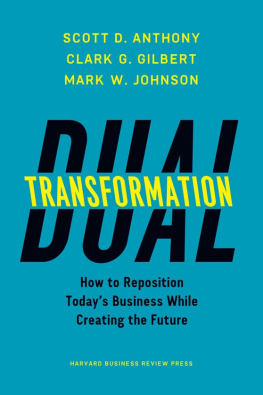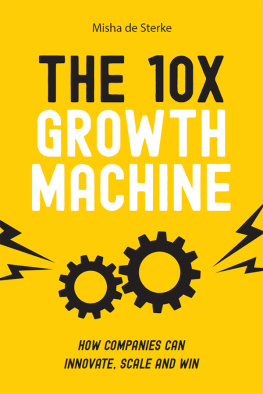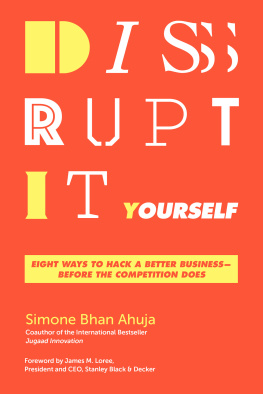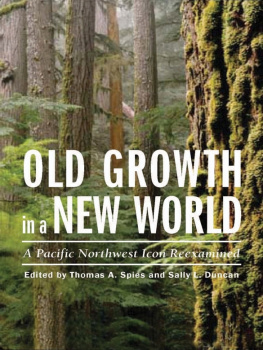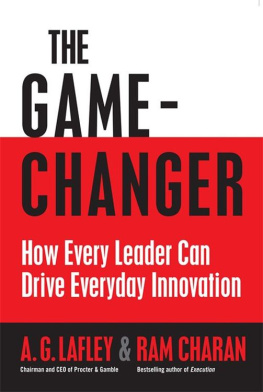ABOUT THE AUTHORS
SCOTT D. ANTHONY is Managing Director of Innosight Asia-Pacific ( www.innosight.com ). Based in Innosights Singapore office, he leads its Asian consulting operations and global venture-capital investing activities (Innosight Ventures). Scott works with leading global companies to develop strategies and innovation capabilities for long-term, sustained growth.
Scotts previous books are Seeing Whats Next: Using the Theories of Innovation to Predict Industry Change; The Innovators Guide to Growth: Putting Disruptive Innovation to Work; The Silver Lining: An Innovation Playbook for Uncertain Times ; and The Little Black Book of Innovation: How It Works, How to Do It . He has written articles for publications such as the Wall Street Journal, Harvard Business Review, Bloomberg Business-Week, Fast Company, Forbes, Sloan Management Review, Advertising Age, Marketing Management , and Chief Executive . He has a regular column at Harvard Business Online ( www.hbr.org ) and his Twitter feed is @ScottDAnthony .
Scott received a BA in economics, summa cum laude, from Dartmouth College and an MBA with high distinction from Harvard Business School, where he was a Baker Scholar. He lives in Singapore with his wife Joanne, sons Charlie and Harry, and daughter Holly.
DAVID S. DUNCAN is a Senior Partner at Innosight ( www.innosight.com ). Based in Innosights Lexington, Massachusetts office, he leads Innosights Capabilities Practice and works with leading global companies to develop strategies and innovation capabilities for long-term, sustained growth.
David has written articles for publications such as Bloomberg BusinessWeek, Managed Care , and Strategy & Innovation , and is a frequent speaker and leader of executive workshops on a broad range of innovation and growth-related topics.
Prior to joining Innosight, David was an engagement manager at McKinsey & Company. He received his BA, magna cum laude, from Duke University, and a PhD in physics from Harvard University. He lives outside of Providence, Rhode Island, with his wife Suzanne and his daughter Zoe.
Component 1: The Growth Blueprint
Growth
blueprint |  |
I N LEWIS CARROLLS classic Alice in Wonderland , a lost Alice seeks guidance from the Cheshire Cat.
Would you tell me, please, which way I ought to go from here? she asks.
That depends a good deal on where you want to get to, the Cat responds.
I dont much care where Alice says.
Then it doesnt matter which way you go, the Cat concludes.
As the old saying goes, if you dont know where you are going, any road will take you there.
A clear growth blueprint is an important first step in the transformation from treating growth as a gamble to approaching it in a more disciplined way. An ideal growth blueprint has two primary elements:
- that clearly define the types of growth strategies the company will pursue
- with specific, shared targets and clear definitions of tactics that are on and off the table
, shows how to get a quick view of your performance in this component.
TABLE 2
| Element | Requires attention | On the way | Desired state |
|---|
| Growth types | No definition of growth types | Defined growth types, at least one of which is noncore; nonspecific classification criterion | Defined growth types with simple, agreed-upon classification criteria |
| Growth goals and guidelines | No clear vision | Directional vision lacking key specifics | Codified and shared growth targets with detailed on- and off-the-table strategic options |
1a. Growth Types
Clear Definitions of the Types of Growth Strategies the Company Will Pursue
Before a company constructs a factory to manufacture a product, it must decide what specifically it wants to produce. The same holds for a growth factory: before constructing one, a company must define clearly the different types of growth it ought to produce. This clarification is important because, as discussed in other sections of this e-book, sustainable growth through innovation requires a company to pursue multiple types of growth at the same time. The company needs to measure, manage, and staff these different types in different ways. A lack of clearly defined growth types almost always suboptimizes one type of idea to the detriment of the whole enterprise.
A theme that we will repeat throughout is that there isnt one perfect way to categorize different types of growth pursuits. For example, P&G has identified four distinct growth types:
- Commercial efforts to increase trial and usage of existing products without changing the product itself. P&Gs innovative Old Spice marketing campaign involving actor Isaiah Mustafa that generated close to 2 billion public relations impressions and propelled the deodorant into category leadership in 2010 was a powerful commercial innovation.
- Sustaining the er innovations that take existing solutions and make them bett er , fast er , cheap er , and so on. Sustaining innovations like new scents or formulations for different washing machines helped the Tide brand grow significantly even in mature markets over the past decade.
- Transformational step-changes whose dramatic improvements reframe a category. An example of this form of innovation is Crest 3D White, a line of advanced oral care products, including one that whitens teeth in two hours.
- Disruptive new brands or business models that win through simplicity or affordability. P&Gs quick cleaning line of Swiffer products disrupted the staid mop-and-broom industry.
Citi has defined a different (though somewhat related) set of growth types to guide its innovation initiatives. Specifically, in 2011, Citi defined three types of innovation:
- Core improvements to existing offerings in existing markets or internal process improvements that increase efficiencies within the current business model. For example, the Citi for Cities team helps government clients improve service levels, efficiency, and security.
- Adjacent new to Citi innovations that either extend existing products to new markets or leverage existing Citi capabilities, assets, or relationships to bring new-to-Citi solutions to market. For example, in 2011, Citi launched Citi Velocity, a new online information channel that allows traders and clients to have instant access to Citi research and real-time market information.
- Disruptive new to the world innovations that reframe markets and create new ones. For example, Citi recently partnered with Jumio, a Silicon Valley start-up that leverages cameras in any mobile phone, tablet, or laptop to increase the security of remote payments.
Setting these definitions was an important step in Citis efforts to manage innovation more systematically. Common definitions enable each of Citis diverse business units to assess and describe their innovation portfolios consistently, positioning Citi to deliver against an important strategic goal of former CEO Pandit: the creation of a Citi-wide innovation portfolio view.
Despite differences in nomenclature, these two organizations define their growth types in ways that share important commonalities:
- At least one type explicitly focuses on noncore growth from new markets or new customer segments.


